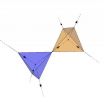(Press-News.org) Vaccination against the hepatitis A virus (HAV) in children two years of age and younger remains effective for at least ten years, according to new research available in the August issue of Hepatology, a journal of the American Association for the Study of Liver Diseases (AASLD). The study found that any transfer of the mother's HAV antibodies does not lower the child's immune response to the vaccine.
The World Health Organization (WHO) estimates that 1.4 million cases of HAV occur worldwide each year. HAV affects the liver and typically occurs in areas with poor sanitation where ingestion of contaminated food or water can transmit the virus. In the U.S., HAV cases have decreased by 90% in the past 20 years, with roughly 20,000 new cases reported each year according to the Centers for Disease Control and Prevention (CDC). Experts attribute the decline in HAV cases in the U.S. to routine vaccination of children 12 to 18 months.
According to lead author Dr. Umid Sharapov, an epidemiologist with the CDC and his coauthors, this is the first study to examine the effectiveness of a two-dose inactivated hepatitis A vaccine in children younger than two years of age over a ten-year period. In addition, the researchers investigated whether maternal anti-HAV antibody transfer to their children impacts the vaccine protection against HAV.
With parental consent, researchers enrolled full-term infants who were healthy at six-months of age. Mothers were tested for total antibody to HAV. The 197 infants and toddlers were broken into three age groups: group one-infants 6 to 12 months; group two-toddlers between 12 and 18 months; and group three-toddlers 15 to 21 months of age. Each group was randomized by maternal anti-HAV status. HAV antibody levels were measured at one and six months, and additional follow-up took place at three, five, seven and ten years after the second dose of hepatitis A vaccine.
At one month following the second dose of the hepatitis A vaccine children in all groups showed signs of protection from the virus. At the ten-year follow-up most children retained anti-HAV protection. In the first group, 7% and 11% of children born to mother's without and with antibodies to the HAV virus, did not retain HAV protection from vaccination, respectively. Additionally, 4% of group three children born to anti-HAV negative mothers lost HAV protection.
"Our study demonstrates that seropositivity to hepatitis A persists for at least ten years after primary vaccination with two-dose inactivated HAV vaccine when administered to children at ages 12 months and older, regardless of their mothers' anti-HAV status," concludes Dr. Sharapov. "These findings support current CDC/ACIP guidelines for routine administration of two doses of inactivated hepatitis A vaccine to all children in the U.S. beginning at the age of 12 months." The authors point out that a future booster dose may be necessary to maintain protection against HAV and they will continue follow-up participants into their teens to monitor benefit of the initial immunization.
INFORMATION:
Full citation: "Persistence of Hepatitis A Vaccine Induced Seropositivity in Infants and Young Children by Maternal Antibody Status: 10-Year Follow-Up." Umid M. Sharapov, Lisa R. Bulkow, Susan E. Negus, Philip R. Spradling, Chriss Homan, Jan Drobeniuc, Michael Bruce, Saleem Kamili, Dale J. Hu, Brian J. McMahon. Hepatology; DOI: 10.1002/hep.25687); Print Issue Date: August, 2012.
URL: http://onlinelibrary.wiley.com/doi/10.1002/hep.25687/abstract
Author Contact: To arrange an interview with Dr. Sharapov, please contact the news media team at CDC's National Center for HIV/AIDS, Viral Hepatitis, STD and TB Prevention at 404-639-8895 or NCHHSTPMediaTeam@cdc.gov.
This study is published in Hepatology. Media wishing to receive a PDF of this article may contact sciencenewsroom@wiley.com .
About the Journal:
Hepatology is the premier publication in the field of liver disease, publishing original, peer-reviewed articles concerning all aspects of liver structure, function and disease. Each month, the distinguished Editorial Board monitors and selects only the best articles on subjects such as immunology, chronic hepatitis, viral hepatitis, cirrhosis, genetic and metabolic liver diseases and their complications, liver cancer, and drug metabolism. Hepatology is published on is published by Wiley on behalf of the American Association for the Study of Liver Diseases (AASLD). For more information, please visit http://wileyonlinelibrary.com/journal/hep.
About Wiley
Founded in 1807, John Wiley & Sons, Inc. has been a valued source of information and understanding for more than 200 years, helping people around the world meet their needs and fulfill their aspirations. Wiley and its acquired companies have published the works of more than 450 Nobel laureates in all categories: Literature, Economics, Physiology or Medicine, Physics, Chemistry, and Peace.
Our core businesses publish scientific, technical, medical, and scholarly journals, encyclopedias, books, and online products and services; professional/trade books, subscription products, training materials, and online applications and Web sites; and educational materials for undergraduate and graduate students and lifelong learners. Wiley's global headquarters are located in Hoboken, New Jersey, with operations in the U.S., Europe, Asia, Canada, and Australia. The Company's Web site can be accessed at http://www.wiley.com. The Company is listed on the New York Stock Exchange under the symbols JWa and JWb.
END
The sought-after equanimity of "living in the moment" may be impossible, according to neuroscientists who've pinpointed a brain area responsible for using past decisions and outcomes to guide future behavior. The study, based on research conducted at the University of Pittsburgh and published today in the professional journal Neuron, is the first of its kind to analyze signals associated with metacognition—a person's ability to monitor and control cognition (a term cleverly described by researchers as "thinking about thinking.")
"The brain has to keep track of decisions ...
Magnetic monopoles, entities with isolated north or south magnetic poles, weren't supposed to exist. If you try to saw a bar magnet in half, all you succeed in getting are two magnets, each with a south and north pole. In recent years, however, the existence of monopoles, at least in the form of "quasiparticles" consisting of collective excitations among many atoms, has been predicted and demonstrated in the lab. Now Stephen Powell, a scientist at the Joint Quantum Institute (JQI*) and the University of Maryland, has sharpened the theoretical framework under which ...
NASA's Tropical Rainfall Measuring Mission satellite, known as TRMM can measure the rate rain is falling with a tropical cyclone from its orbit in space, and data from August 9 reveals areas of heavy rainfall in Tropical Storm Ernesto as it heads for a second landfall in Mexico.
The TRMM satellite saw tropical storm Ernesto on August 9, 2012 at 0656 UTC (2:36 a.m. EDT) after it moved from the Yucatan Peninsula into the Gulf of Mexico. An analysis of TRMM Microwave Imager (TMI) and Precipitation Radar (PR) rainfall shows that powerful convective thunderstorms were dropping ...
Sea surface temperatures cooler than 80 degrees Fahrenheit can sap the strength from a tropical cyclone and Tropical Storm Kirogi is headed toward waters below that threshold on its track through the northwestern Pacific Ocean, according to data from NASA's Aqua satellite.
NASA's Aqua satellite passed over Tropical Storm Kirogi on August 9 at 0241 UTC. The Atmospheric Infrared Sounder (AIRS) instrument captured an infrared image of the cloud temperatures that showed a concentrated area of strongest storms and heaviest rainfall west of the center of circulation. Vertical ...
Follow-up research from the Pediatric Study of Hepatitis C (PEDS-C) trial reveals that children treated with peginterferon alpha (pegIFNα) for hepatitis C (HCV) display significant changes in height, weight, body mass index (BMI), and body composition. Results appearing in the August issue of Hepatology, a journal of the American Association for the Study of Liver Diseases, indicate that most growth-related side effects are reversible with cessation of therapy. However, in many children the height-for-age score had not returned to baseline two years after stopping ...
(Boston) – Researchers from Boston University School of Medicine (BUSM) and Veterans Affairs (VA) Boston Healthcare System have demonstrated that the effects on white matter brain volume from long-term alcohol abuse are different for men and women. The study, which is published online in Alcoholism: Clinical and Experimental Research, also suggests that with abstinence, women recover their white matter brain volume more quickly than men.
The study was led by Susan Mosher Ruiz, PhD, postdoctoral research scientist in the Laboratory for Neuropsychology at BUSM and research ...
CAMBRIDGE, MA -- Earthworms creep along the ground by alternately squeezing and stretching muscles along the length of their bodies, inching forward with each wave of contractions. Snails and sea cucumbers also use this mechanism, called peristalsis, to get around, and our own gastrointestinal tracts operate by a similar action, squeezing muscles along the esophagus to push food to the stomach.
Now researchers at MIT, Harvard University and Seoul National University have engineered a soft autonomous robot that moves via peristalsis, crawling across surfaces by contracting ...
NASA scientist Tom Hanisco is helping to fill a big gap in scientists' understanding of how much urban pollution -- and more precisely formaldehyde -- ultimately winds up in Earth's upper atmosphere where it can wreak havoc on Earth's protective ozone layer.
He and his team at NASA's Goddard Space Flight Center in Greenbelt, Md., have developed an automated, lightweight, laser-induced fluorescence device that measures the levels of this difficult-to-measure organic compound in the lower troposphere and then again at much higher altitudes. The primary objective is determining ...
Many of the long term goals people strive for — like losing weight — require us to use self-control and forgo immediate gratification. And yet, denying our immediate desires in order to reap future benefits is often very hard to do.
In a new article in the August issue of Current Directions in Psychological Science, a journal of the Association for Psychological Science, researchers Kentaro Fujita and Jessica Carnevale of The Ohio State University propose that the way people subjectively understand, or construe, events can influence self-control.
Research from psychological ...
NEW YORK, N.Y. (August 9, 2012) – Over 400 attendees from across the U.S. and around the world participated in the first national conference for families and professionals, "Treating the Whole Person with Autism: Comprehensive Care for Children and Adolescents with ASD."
Autism Speaks, the world's leading autism science and advocacy organization, organized and hosted the conference in collaboration with educational partners at Nationwide Children's Hospital (NCH), The Ohio State University Wexner Medical Center, the American Academy of Pediatrics (AAP), and the Health ...




